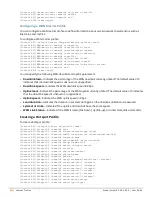
Aruba Instant 6.5.0.0-4.3.0.0 | User Guide
Hotspot Profiles |
372
Chapter 32
Hotspot Profiles
This chapter contains the following topics:
l
Understanding Hotspot Profiles on page 372
l
Configuring Hotspot Profiles on page 374
l
Sample Configuration on page 385
In the current release, Instant supports the hotspot profile configuration only through the CLI.
Understanding Hotspot Profiles
Hotspot 2.0 (Passpoint Release 1) is a Wi-Fi Alliance specification based on the 802.11u protocol, which allows
wireless clients to discover hotspots using management frames (such as beacon, association request, and
association response), connect to networks, and roam between networks without additional authentication.
Hotspot 2.0 provides the following services:
l
Network discovery and selection—Allows the clients to discover suitable and available networks by
advertising the access network type, roaming consortium, and venue information through the management
frames. For network discovery and selection, Generic Advertisement Service (GAS) and Access Network
Query Protocol (ANQP) are used.
l
QOS Mapping—Provides a mapping between the network-layer QoS packet marking and over- the-air QoS
frame marking based on user priority.
When a hotspot is configured in a network:
l
The clients search for available hotspots using the beacon management frame.
l
When a hotspot is found, the client sends queries to obtain information about the type of network
authentication and IP address, and IP address availability using the Generic Advertisement Service (GAS)
action frames.
l
Based on the response of the advertisement server (response to the GAS Action Frames), the relevant
hotspot is selected and the client attempts to associate with it.
l
Based on the authentication mode used for mobility clients, the client authenticates to access the network.
Generic Advertisement Service (GAS)
GAS is a request-response protocol, that provides L2 transport mechanism between a wireless client and a
server in the network prior to authentication. It helps to determine an 802.11 infrastructure before associating
clients and allows clients to send queries to multiple 802.11 networks in parallel.
















































